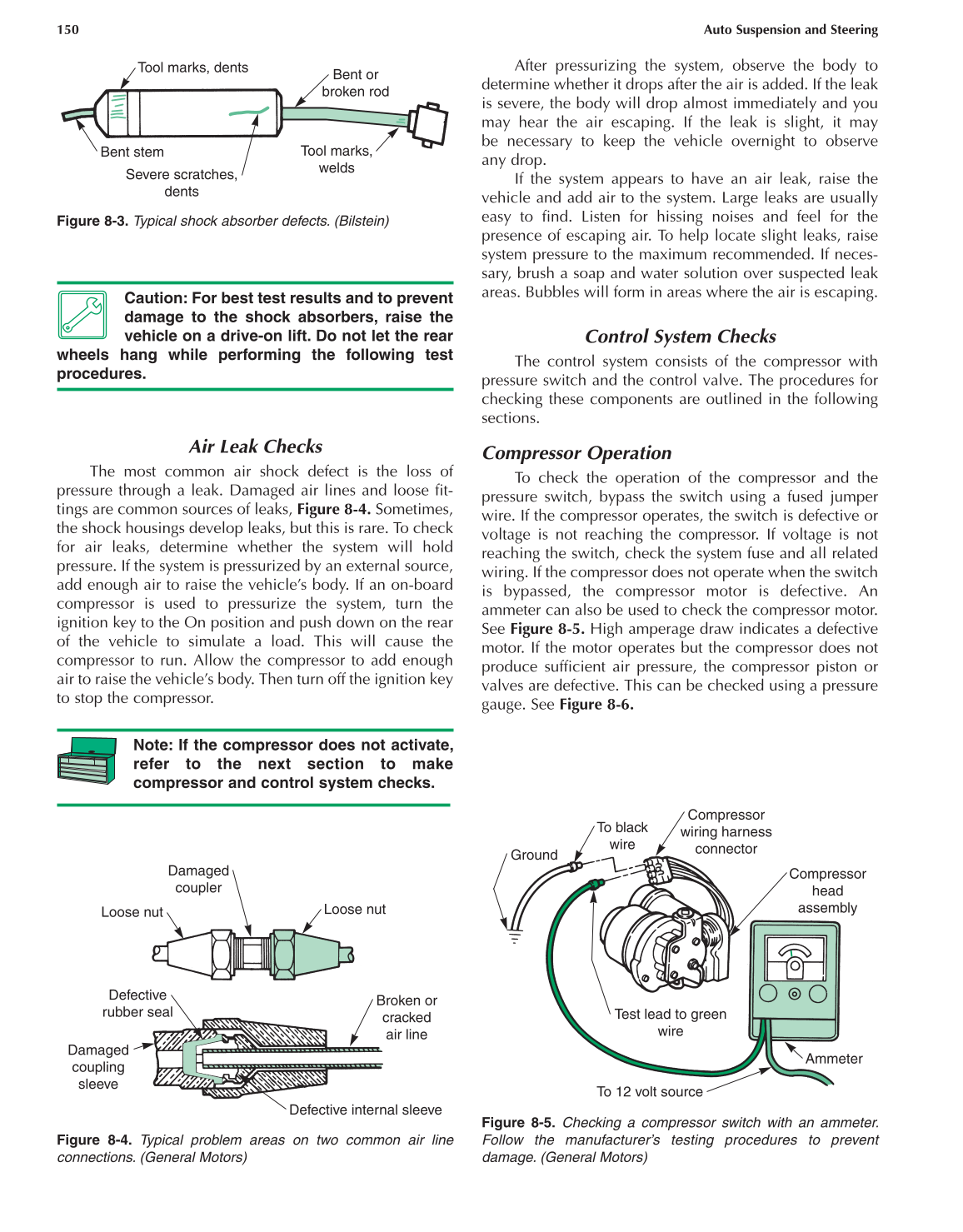150 Auto Suspension and Steering
Caution: For best test results and to prevent
damage to the shock absorbers, raise the
vehicle on a drive-on lift. Do not let the rear
wheels hang while performing the following test
procedures.
Air Leak Checks
The most common air shock defect is the loss of
pressure through a leak. Damaged air lines and loose fit-
tings are common sources of leaks, Figure 8-4. Sometimes,
the shock housings develop leaks, but this is rare. To check
for air leaks, determine whether the system will hold
pressure. If the system is pressurized by an external source,
add enough air to raise the vehicle’s body. If an on-board
compressor is used to pressurize the system, turn the
ignition key to the On position and push down on the rear
of the vehicle to simulate a load. This will cause the
compressor to run. Allow the compressor to add enough
air to raise the vehicle’s body. Then turn off the ignition key
to stop the compressor.
Note: If the compressor does not activate,
refer to the next section to make
compressor and control system checks.
After pressurizing the system, observe the body to
determine whether it drops after the air is added. If the leak
is severe, the body will drop almost immediately and you
may hear the air escaping. If the leak is slight, it may
be necessary to keep the vehicle overnight to observe
any drop.
If the system appears to have an air leak, raise the
vehicle and add air to the system. Large leaks are usually
easy to find. Listen for hissing noises and feel for the
presence of escaping air. To help locate slight leaks, raise
system pressure to the maximum recommended. If neces-
sary, brush a soap and water solution over suspected leak
areas. Bubbles will form in areas where the air is escaping.
Control System Checks
The control system consists of the compressor with
pressure switch and the control valve. The procedures for
checking these components are outlined in the following
sections.
Compressor Operation
To check the operation of the compressor and the
pressure switch, bypass the switch using a fused jumper
wire. If the compressor operates, the switch is defective or
voltage is not reaching the compressor. If voltage is not
reaching the switch, check the system fuse and all related
wiring. If the compressor does not operate when the switch
is bypassed, the compressor motor is defective. An
ammeter can also be used to check the compressor motor.
See Figure 8-5. High amperage draw indicates a defective
motor. If the motor operates but the compressor does not
produce sufficient air pressure, the compressor piston or
valves are defective. This can be checked using a pressure
gauge. See Figure 8-6.
Bent stem
Tool marks, dents
Severe scratches,
dents
Bent or
broken rod
Tool marks,
welds
Figure 8-3. Typical shock absorber defects. (Bilstein)
Loose nut
Damaged
coupler
Loose nut
Defective
rubber seal
Damaged
coupling
sleeve
Defective internal sleeve
Broken or
cracked
air line
Figure 8-4. Typical problem areas on two common air line
connections. (General Motors)
To black
wire
Compressor
wiring harness
connector
Compressor
head
assembly
Ammeter
To 12 volt source
Test lead to green
wire
Ground
Figure 8-5. Checking a compressor switch with an ammeter.
Follow the manufacturer’s testing procedures to prevent
damage. (General Motors)
